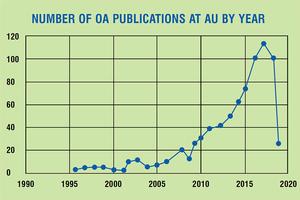Science
The Movement toward Open Information at American University

The “open movement” is a series of related efforts, with the goal of making information freely available to all. This article introduces several key efforts within the larger movement and highlights how American University is working toward this goal.
Open Access
Open access (OA) refers to scholarly literature that is free to access, reuse, and redistribute. Under the current model, the publication cycle tends to look like this: A researcher conducts a study and writes up their findings. Then they submit their manuscript to a scholarly journal for publication, and it may be published after thorough review by the editor and expert peer reviewers. In order to access this article, however, a reader must pay either the journal subscription fee or a one-time fee for the individual article. An OA publication goes through a similar process, but once published, the article is freely available to anyone without a subscription. It is not hidden behind a paywall.
Some argue that hiding research behind a paywall is unethical, especially when the research was conducted using tax-funded grants. In these cases, taxpayers essentially pay twice for the research. College and university libraries pay for access to journals, but as prices increase and budgets tighten, librarians are often forced to cancel subscriptions. In addition, there are many scholars and researchers all over the world, especially in the Global South, who do not have the funds to access information that is hidden behind a paywall.
Open access may be the future of scholarly publishing, but it is not yet clear how it will manifest—or who will pay for it. One model involves article processing charges (APCs), in which authors pay a fee to publish their research. Sometimes these fees are written into a grant proposal. The Gates Foundation, for example, has committed to paying these fees so that research will be “accessible and open immediately.”
However, not all research is grant-supported. To address this gap in funded research and support, American University’s library maintains an Open Access Fund that pays APCs for articles that meet criteria designed to ensure publication in high quality journals. In the 2018- 19 year, the library paid the APCs for eleven articles from a variety of disciplines. Research topics included sexual education in Nigeria, color processing in zebrafish retina, and the role of magnesium in neurological disorders. Interest in publishing OA is increasing at AU. In 1996, only three percent of AU faculty’s total research output was openly available, but this percentage has increased steadily. In 2017, eighteen percent of AU research output was published OA.
Open Education Resources
Rising costs of textbooks and other course materials is frustrating for students, particularly in STEM disciplines, where a single textbook can cost hundreds of dollars and rapidly depreciate in value. More recently, several universities and funding agencies, including the Department of Education, are supporting the creation and use of open access textbooks and other instructional materials as an alternative to traditional textbooks. AU’s Center for Research, Teaching and Learning (CTRL) offers a grant for any faculty member to convert a course to one that only uses OERs. The program has already saved students more than $500,000 in textbook costs. CTRL also offers support and grants for the development of an open educational resource, such as writing or updating an openly available textbook.
Open Science
As the discussion around paywalled research continues, a parallel discussion is taking place about the openness and availability of all of the supplementary information involved in scientific research. This supplementary information includes data, methodology and tools, programs and codes, and even steps in the research process that are generally ‘invisible’ to the public, such as peer review comments, grant proposals, and personal research libraries. The open science movement seeks to make all of this information openly accessible to researchers and members of the public, to help drive scientific innovation through cooperative efforts. Dr. Mark Laubach, director of AU’s Computational Systems and Neuroscience Lab, has played a major role in making open science a reality. As part of his ongoing research efforts, Dr. Laubach also manages OpenBehavior.com, a repository of open source tools and methodologies for behavioral neuroscience researchers.
Conclusion
The rising costs of research contributes to rising tuition costs at universities. Library subscriptions demand significant budgetary allocations to maintain access to current research and resources. The open movements described here are intended to disrupt the current research landscape in order to balance inequitable information privileges and access. Collaboration and innovation in research are stifled when researchers do not have access to these costly materials. The library and CTRL are proud supporters of these open movements, and hope to help make accessible research a reality.